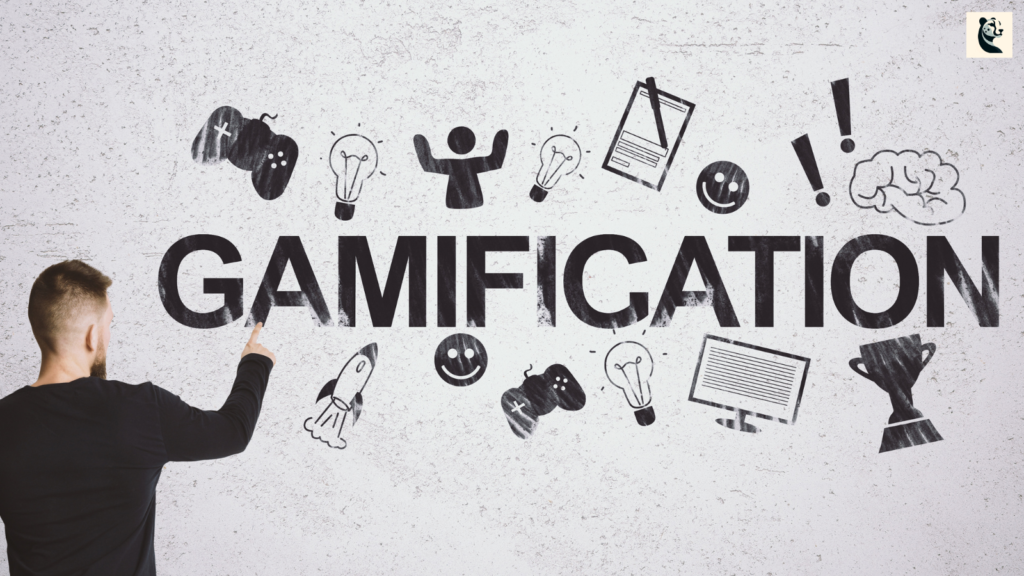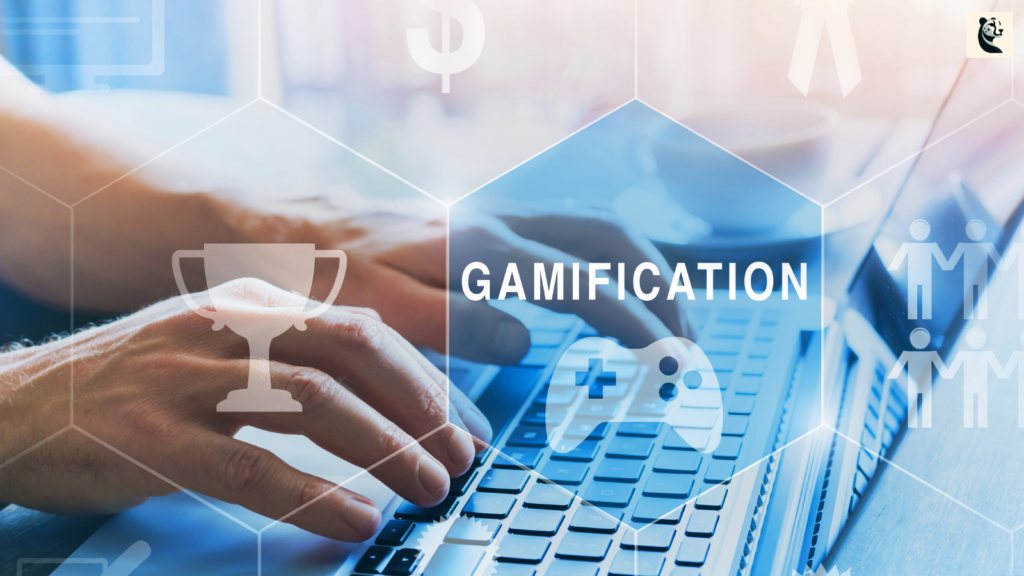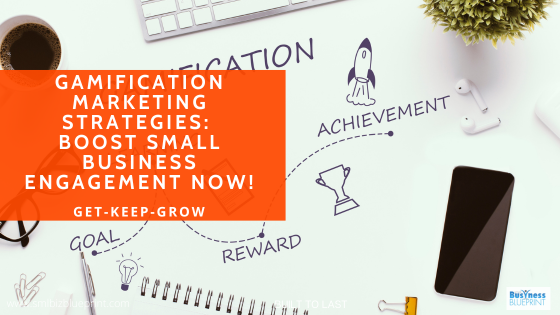Small businesses must find innovative ways to engage customers and build lasting loyalty.
One increasingly popular strategy is gamification—applying game-design elements to non-game contexts like marketing.
By incorporating gamified experiences into their digital marketing strategies, small businesses can boost customer engagement and brand loyalty while creating a unique and enjoyable customer journey.
This guide will help you discover the core principles of gamification and why it’s essential for modern marketing.
We’ll explore actionable strategies, practical incentive ideas, and tactics to help you design personalised gamified experiences that resonate with your target audience.
You’ll also learn how to measure the success of your campaigns and stay updated with emerging trends in 2024 to evolve your strategy over time.

Whether you’re just beginning to experiment with gamification or looking to refine your existing approach, this comprehensive guide will provide the practical insights you need to elevate your digital marketing game.
#1 Understanding Gamification in Marketing
Gamification in marketing isn’t just a trend; it’s a transformative strategy that applies games’ fun and engaging elements to marketing activities.
By incorporating challenges, rewards, and interactive components, businesses can motivate actions and foster deeper connections with their audience.
What is Gamification?
At its core, gamification involves using game mechanics in a non-game context.
This includes elements like points, leaderboards, achievement badges, and levels designed to increase participation by tapping into the natural human desires for competition and achievement.
For example, a customer might earn points for each purchase or action, which can later be exchanged for discounts or special offers.
The Benefits of Gamification
Gamification’s primary goal is to enhance customer engagement and retention. According to research by Gartner, more than 70% of global organisations will have at least one gamified application by 2024, highlighting its increasing adoption.
Here’s why gamification is crucial for your marketing efforts:
- Increased Engagement: Gamified elements make interactions fun and engaging, encouraging users to spend more time with your brand.
- Enhanced Loyalty: By rewarding participation and purchases, gamification can turn casual customers into loyal advocates.
- Data Collection: As users interact with gamified elements, they generate valuable data on their preferences and behaviour, which can be used to refine marketing strategies.
Gamification in Action: A Real-World Example
A practical example of successful gamification in marketing is Starbucks’s Rewards program. The program uses a point system where customers earn ‘stars’ for each purchase. These stars can be used to redeem free products and upgrades, motivating continued patronage and enhancing customer satisfaction.
Why It Matters for Small Businesses
For small businesses, gamification provides a unique opportunity to compete with larger players by offering memorable and personalised customer experiences.
It’s an effective way to attract new customers, enhance customer satisfaction, and drive loyalty, which are crucial for sustained business growth.
By understanding the essence and benefits of gamification in marketing, small businesses can leverage this powerful tool to make their marketing strategies more engaging and effective.
Whether you’re looking to introduce a simple point system or a full-fledged interactive campaign, gamification principles can significantly enhance how customers interact with your brand.
#2 Top Gamification Strategies for Small Businesses to Drive Engagement
Small businesses have unique opportunities to leverage gamification to captivate their audience and build stronger relationships.
The right strategies can transform casual visitors into loyal advocates, amplifying word-of-mouth referrals and repeat sales.
Here are some practical gamification strategies that can work effectively for your small business:
Quizzes and Challenges
Overview: Create fun and informative quizzes or challenges related to your industry or brand. For instance, a fitness brand could quiz users on nutrition facts, offering rewards like discount coupons for high scores.
Benefits: Quizzes and challenges engage customers by allowing them to demonstrate their knowledge and earn rewards while learning more about your products and services.
Leaderboards
Overview: Introduce leaderboards that showcase the top participants in your campaigns. For example, a clothing retailer could feature customers who accumulate the most weekly reward points or share the most user-generated content.
Benefits: Leaderboards leverage people’s desire for social recognition and competition, encouraging them to stay active and involved with your brand.
Referral Programs
Overview: Encourage current customers to refer friends and family in exchange for rewards. For each successful sign-up, a SaaS company could offer both the referrer and the new user a month of free service.
Benefits: Referral programs leverage existing relationships, driving growth through word-of-mouth and increasing engagement through rewards.
Loyalty Points System
Overview: Introduce a points-based system where customers earn points through interactions such as making purchases, writing reviews, or sharing posts on social media.
Benefits: Loyalty points reinforce positive behaviour, encouraging customers to remain loyal by unlocking exclusive rewards and experiences.
Gamification Strategy in Practice
An inspiring example is Nike’s Nike+ Run Club app, which uses multiple gamification strategies to motivate runners. The app includes quizzes and leaderboards and lets users earn badges for completing challenges or hitting running milestones. These strategies foster friendly competition among users and keep them committed to their fitness journey.
Key Takeaways
- Tailored to Your Audience: Understand your audience’s preferences and tailor quizzes, leaderboards, or point systems that resonate with their interests.
- Clear Goals: Set up simple goals that customers can easily understand and strive to achieve.
- Consistent Rewards: Offer consistent rewards to incentivise ongoing participation and encourage users to return.
By integrating these strategies into your digital marketing efforts, your small business can capture customers’ attention, motivate continued interaction, and nurture deeper brand loyalty.

#3 Ideas for Gamified Marketing Campaigns
Crafting effective incentives is crucial to any successful gamified marketing campaign. The right rewards can motivate customers to participate, share, and return for more interactions.
Here are some ideas for creating appealing and effective incentives for your gamification strategy:
Virtual Badges
Overview: Award digital badges when customers complete tasks or challenges, such as writing product reviews, sharing content, or reaching milestones.
Benefits: Badges provide visible recognition of achievement and foster a sense of accomplishment. They can also unlock exclusive perks, like early access to new products or premium content.
Exclusive Content
Overview: As a reward for customer engagement, offer access to unique content like tutorials, behind-the-scenes videos, or expert guides.
Benefits: Exclusive content adds extra value to the customer experience, particularly for industries with valued expertise (e.g., fitness, education, technology).
Loyalty Points
Overview: Create a points system where customers accumulate points for purchases, reviews, and referrals. Points can be redeemed for discounts, freebies, or special experiences.
Benefits: Points systems encourage repeat business and referrals while providing valuable insights into customer preferences and behaviour.
Free Products or Upgrades
Overview: Give customers free samples or trial versions of products or upgrade their service tier for a limited time when they meet specific goals.
Benefits: Free products or upgrades serve as a tangible incentive, increasing the perceived value of participating in the campaign.
Real-World Example
A notable example is Duolingo, which uses virtual badges to recognise language learners for completing lessons and practising daily. The app also offers streak rewards for consecutive days of practice, fostering a sense of commitment and achievement that keeps users returning.
Key Takeaways
- Understand Your Audience: Ensure your rewards align with your audience’s values and finds motivating. Consider surveys or focus groups to learn more.
- Balance Effort and Reward: Make rewards proportional to the level of effort required. For instance, a simple review might earn a badge, while accumulating significant points could unlock premium content.
- Tiered Incentives: Implement tiered rewards to provide ongoing motivation. Start with basic perks and gradually offer more exclusive rewards as customers progress.
These strategies will help you design a gamified marketing campaign that captures attention and keeps customers returning for more.
#4 Strengthen Brand Loyalty through Gamification
In an increasingly competitive digital world, strengthening brand loyalty is vital for small businesses’ long-term success. Gamification offers a unique opportunity to enhance customer relationships by making interactions fun and rewarding.
Here are several tactics to consider:
Design Gamified Experiences Aligned with Your Brand Story
Overview: Ensure that gamified experiences reflect your brand values and identity. For instance, if sustainability is core to your brand, incorporate eco-friendly challenges into your campaigns.
Benefits: Consistent branding creates a seamless customer journey where your core values resonate throughout their experience, deepening the emotional connection with your audience.
Foster Community with Collaborative Challenges
Overview: Create challenges that encourage customers to work together by sharing their achievements or collectively contributing to a goal.
Benefits: Collaborative challenges build a sense of belonging among participants, fostering a supportive brand community and increasing the likelihood of social sharing.
Personalize Rewards and Experiences
Overview: Tailor challenges and rewards to individual customers based on their preferences, past behaviour, and demographic information.
Benefits: Personalization increases the perceived value of rewards, making them more meaningful and encouraging repeat participation.
Real-World Example
Sephora’s Beauty Insider program stands out for its tiered loyalty system, which segments customers into tiers based on their spending. Each tier offers progressively exclusive rewards and experiences, such as early product access or free makeup tutorials. This system aligns with Sephora’s focus on personalised beauty and fosters loyalty by offering customers benefits that resonate with their interests.
Key Takeaways
- Start with Your Brand: Define how your gamification strategy will align with your brand values and storytelling. This helps ensure consistency and authenticity.
- Encourage Interaction: Build challenges that inspire customers to interact and share through social media or within your platform.
- Adapt to Feedback: Gather and analyse customer feedback to refine and improve your gamification tactics over time.
These tactics will help you strengthen your brand’s loyalty and grow your community through engaging and personalised gamified experiences.

#5 Measuring the Success of Gamification in Marketing Campaigns
Measuring the effectiveness of gamification is essential to ensure your marketing campaigns deliver the desired outcomes. Understanding key metrics and adjusting your strategies will maximise ROI and improve future campaigns.
Here are crucial factors and best practices for assessing the success of your gamified marketing:
Identify Clear KPIs
Overview: Establish key performance indicators (KPIs) that align with your marketing goals, such as customer engagement, retention, or lead generation.
Benefits: Clear KPIs provide measurable objectives that allow you to track progress and assess the campaign’s overall effectiveness. For example, if the goal is customer engagement, track metrics like time spent, shares, and comments.
Monitor Engagement Metrics
Overview: Engagement metrics include active users, time on site, page views, and social shares, which reflect the level of customer interest and involvement.
Benefits: High engagement indicates that the gamification elements are compelling. Track engagement metrics across different stages to refine strategies.
Assess Conversion Rates
Overview: Analyze conversion rates for key actions, such as sign-ups, purchases, or referrals, to gauge how well the campaign drives desired behaviours.
Benefits: Conversion rates reveal how effectively your campaign motivates customer actions, providing valuable insights into which gamified elements are most successful.
Customer Feedback and Surveys
Overview: Collect qualitative participant data via feedback forms, polls, or interviews to understand customer preferences and pain points.
Benefits: Customer feedback helps identify what’s working and what isn’t, offering a deeper understanding of how your gamified campaign is received.
Real-World Example
Nike’s NikeFuel Band is an excellent example of how gamification metrics can inform marketing decisions. Nike used data from the band’s user activity to refine their approach, learning which challenges or incentives resonated most with their audience.
Key Takeaways
- KPIs are Crucial: Start by defining KPIs that align with your marketing objectives so your tracking remains focused and relevant.
- Compare and Improve: Use metrics to compare different campaigns and improve future strategies by building on past successes or avoiding identified pitfalls.
- Incorporate Feedback: Use customer insights to optimise incentives and engagement strategies, making the experience more rewarding and effective.
By carefully measuring success and refining your approach, your gamification campaigns can consistently yield strong customer engagement and loyalty.
#6 Emerging Trends in Gamification for 2024 and Beyond
Staying ahead of emerging trends can give small businesses a competitive edge and enable them to develop more engaging and effective gamification strategies.
Here are the key gamification trends to watch for in 2024 and beyond:
Hybrid Gamification Experiences
Overview: As virtual and in-person experiences increasingly blend, hybrid gamification leverages online and offline engagement. This can involve using QR codes at physical locations to unlock online rewards.
Benefits: Hybrid gamification maximises brand touchpoints, appealing to customers who value digital and in-person interactions.
AI-Powered Personalization
Overview: Artificial Intelligence (AI) is transforming gamification with its ability to analyze vast amounts of customer data and deliver hyper-personalized challenges and rewards.
Benefits: AI-driven personalisation ensures customers receive experiences that align closely with their interests, improving engagement and loyalty.
Gamified E-Learning and Training
Overview: More businesses are incorporating gamified e-learning and training programs into their marketing strategies, especially for educating customers or onboarding new users.
Benefits: These programs offer a fun and interactive way to learn about products, services, or industry topics, fostering a deeper understanding and appreciation of your brand.
Blockchain-Based Rewards
Overview: Blockchain technology is increasingly used to create unique, tradable digital assets, like NFTs (non-fungible tokens), which can be incorporated into gamified reward systems.
Benefits: Blockchain-based rewards allow businesses to offer scarce, unique incentives that customers can collect, trade, or even sell, creating a stronger sense of ownership and value.
Key Takeaways
- Adapt to Hybrid Engagement: Plan strategies that span physical and digital experiences to maximise engagement across all customer touchpoints.
- Invest in Personalization: Embrace AI-powered tools to personalise customer experiences and make rewards more relevant and appealing.
- Gamify Learning: Consider developing gamified learning modules to help customers get the most out of your products and services.
- Explore New Technologies: Look into blockchain-based incentives to offer innovative, value-driven rewards that build brand loyalty.
These emerging trends can help you keep your gamification strategies fresh, relevant, and impactful for your customers, ensuring they stay engaged and loyal to your brand.
Conclusion
Gamification offers small businesses a unique opportunity to captivate their audience, boost engagement, and build lasting brand loyalty.
Integrating engaging elements like quizzes, leaderboards, referral programs, and hybrid experiences into your digital marketing strategy allows you to transform casual visitors into loyal customers who actively participate in your brand’s community.
In this guide, we’ve explored how to effectively implement gamification to align with your brand story, incentivise customer actions, and personalise experiences for maximum impact.
Whether using virtual badges, exclusive content, or blockchain-based rewards, these approaches can be tailored to your specific audience and goals.
With the right measurement tools and emerging trends, you can refine and adapt your gamified marketing campaigns to stay relevant and impactful in 2024 and beyond.
Ready to take your digital marketing strategy to the next level with gamification?
Start by identifying your key performance indicators and designing campaigns aligned with your brand story. Experiment with different gamified experiences, and don’t hesitate to refine your approach based on feedback and data insights.
With a strong strategy, you’ll be well on your way to creating memorable and engaging experiences that keep customers returning for more.
FAQs
Q1: What is gamification, and how can it benefit small businesses in their digital marketing?
A1: Gamification uses game elements in non-game contexts, like marketing, to enhance customer engagement. For small businesses, it can incentivise desirable behaviours, such as making purchases, sharing content, or referring friends. This creates a fun, rewarding experience that fosters customer loyalty.
Q2: What are some effective gamification strategies for small businesses?
A2: Start with quizzes, challenges, or leaderboards that align with your brand values. Referral programs and loyalty points systems are also effective, providing straightforward ways to boost engagement and encourage repeat interactions.
Q3: How do you measure the success of a gamification campaign?
A3: Define clear KPIs that align with your marketing goals. Track engagement metrics, conversion rates, and customer feedback to assess effectiveness. Comparing these results against past campaigns will help refine your strategy.
Q4: How can small businesses offer meaningful rewards without straining their budget?
A4: Offer rewards that resonate with your audience, such as virtual badges, exclusive content, or discounts. Ensure that rewards are proportional to the effort required to earn them. Tiered reward systems can also help you manage costs.
Q5: How can gamification build stronger brand loyalty?
A5: By aligning gamified experiences with your brand story, providing personalised challenges, and fostering community through collaborative efforts, customers feel more connected to your brand. This motivates them to remain loyal and share their positive experiences.
Q6: What emerging gamification trends should small businesses be aware of?
A6: Key trends include hybrid gamification (online and offline engagement), AI-powered personalisation, and blockchain-based rewards. Gamified e-learning and training are also gaining traction for customer education and onboarding.
Q7: What tools can help small businesses implement and manage gamified marketing campaigns?
A7: Platforms like Gametize, Kahoot!, and Qualtrics offer robust tools for designing challenges, tracking metrics, and analysing feedback. Loyalty management systems like Smile.io and ReferralCandy help manage rewards programs effectively.
Other Articles
Empower Your Business: 10 Data-Driven Actions For Small Business
SMS Marketing: Essential Guide for Small Businesses to Boost Sales
The Ultimate Guide to Implementing a Kanban System in Your Small Business




